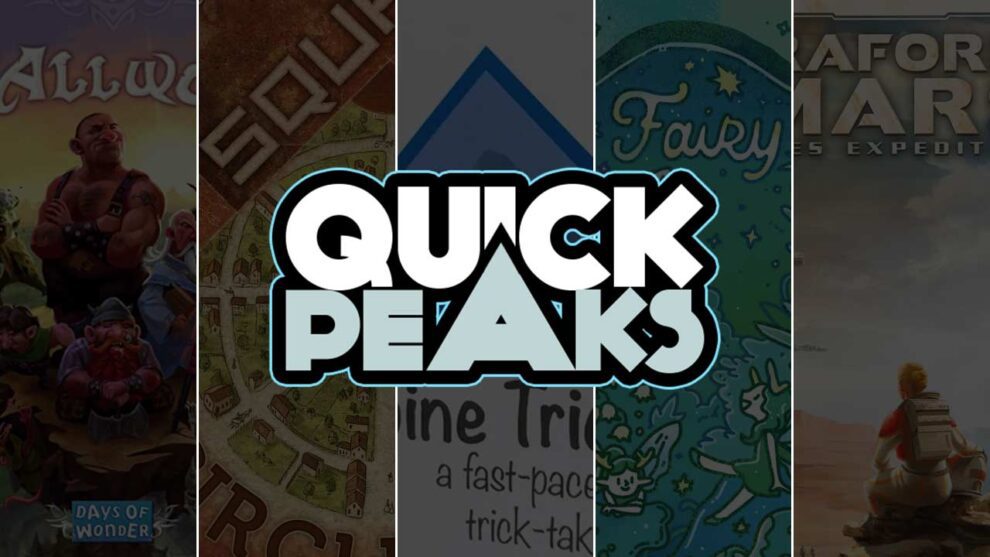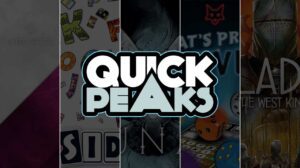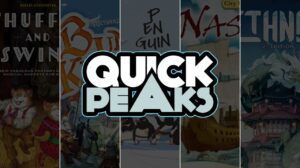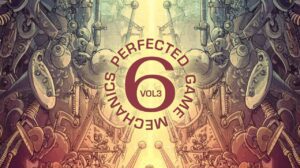Small World (Collector’s Edition) – K. David Ladage
I love Small World. It is a wonderful game that my friend, Steve, and I played a lot back when new stuff was coming out for it on a regular basis. Steve is the kind of a guy that would give serious consideration to buying the over-the-top, extremely over-engineered, exceedingly expensive, will-not-fit-into-any-game-shelf-you-are-going-to-find Collector’s Edition. And so he did. He bought this thing.
The issue with this is that every single element of this game is some 50% larger than it was in the original and made of either wood or plastic. The giant wooden box needs a sticker warning you that this is a two-man lift! Thus, despite having owned this edition since it first came out years and years ago, he has not had many opportunities to pull it out with someone who would appreciate this product. Well, I was there and he wanted to play Small World. So out it came. We played a two-player game–and despite the small player count, this behemoth still managed to fill his 4-by-8 game table. We still had to keep a few elements (like the race tokens) in their giant trays on chairs just off the playing surface. The game was fun! The game was epic! The game was too dang much!
I love Small World. But having experienced it now with thick wooden pieces that take up twice the room on the table as they needed to… I would say I have experienced that copy just enough times to last me a lifetime. I have my original. I will stick with that.
Ease of entry?:
★★★★★ – No sweat
Would I play it again?:
★★☆☆☆ – Would play again but would rather play something else
Read more articles from K. David Ladage.
Squaring Circleville – Andy Matthews
I like history as much as the next person, but when you give me an interesting game based on a true story, you’ve got my attention. Such is the case for Squaring Circleville by Matt Wolfe and Spielworxx; a game that I included on my most anticipated list of Essen SPIEL 2021.Founded in 1810, the town of Circleville, Ohio was constructed in a radial pattern, but by 1837 the residents were so unhappy with the layout, they petitioned the state to allow them to “square the circle”; requiring a rebuild of nearly every building, road, and public utility. Thankfully the game doesn’t require anywhere near that much effort.
In Squaring Circleville, players send their workers all over the town to perform 4 main actions: tearing down old buildings and old roads, and building new buildings and new roads. As sections of town are completed, cardboard overlays are placed on the map, which by the end of the game causes the original radial design to be completely replaced with the new version of the map.
I normally don’t like solo play, but I took the hit this time so that I could learn the game in order to teach it to my group. Once you get past some of the issues with the rulebook, the game plays pretty well. And it’s a cool feeling to slowly replace parts of the city with bright and shiny. I’m looking forward to a future play with real people, and perhaps even a review?
Ease of entry?:
★★★☆☆ – There were a few questions
Would I play it again?:
★★★★☆ – Would like to play it again
Read more articles from Andy Matthews.
Alpine Tricks – Andrew Lynch
Alpine Tricks isn’t a new game. Hardly. It’s Schnapsen, a traditional German card game for two that’s been around since at least the 1700s. Alpine Tricks is instead a specialized deck, intended to make the game more accessible and approachable for the uninitiated. Like most Bavarian trick-taking games, the rules of Schnapsen are labyrinthine, full of unusual twists and turns. Designer Greg Lichtensteiner has set out to create a deck that includes helpful explanations and reminders on each of the cards, and at that he has succeeded.
I adore these sorts of projects, and will always support them when I can. Schnapsen is not my favorite Bavarian card game, that would be Schafkopf, but it’s still an enjoyable game, and will be of interest to the trick-taking cognoscenti among you. I love bringing traditional games into the present, so none of us forget where the modern version of this hobby came from.
Ease of entry?:
★★★★☆ – The odd bump or two
Would I play it again?:
★★★★☆ – Would like to play it again
Read more articles from Andrew Lynch.
Fairy – Justin Bell
Some of the “tiny box” games I picked up from Allplay at Gen Con 2024 are so light that you could knock out your feelings in just a few words. Fairy is one of those games!
Players have a score tracker that they hold onto with one hand, pinching the number representing their score. Their other hand is used to provide one of four hand signals before a new card from the 21-card draw deck is revealed—a guess of what the next card will reveal. Point up (you think the next card number will be higher), down (lower), sideways (the next card will be in the same suit as the most recent visible discard), or a claw, which means you think the next card will be one of the three fairies seeded in the deck. Guessing correctly scores 2-7 points, with the fairy guesses netting the biggest prizes. When someone scores 24 points, or when the draw deck is gone, whoever has the most points wins.
Fairy accommodates 2-10 players ages 6+, so as a family-weight game before dinner, it’s hard to go wrong with something this simple. Then again, the game is so simple that it feels just like it was designed, as a press-your-luck activity that allows everyone to play it safe or go big to score more points. (If a player is ever wrong with their bid, they only lose one point.) During a recent six-player game night, all five opponents finished the first game and said they wouldn’t choose to play it again. That was enough for me to say that for core gamers, Fairy is a miss, but for something fine to do with my kids, Fairy isn’t bad.
Ease of entry?:
★★★★★ – No sweat
Would I play it again?:
★★☆☆☆ – Would play again but would rather play something else
Read more articles from Justin Bell.
Terraforming Mars: Ares Expedition – Tom Franklin
My gaming group loves Terraforming Mars, so when I had the chance to pick up a cheap copy of Terraforming Mars: Ares Expedition, I thought I’d take a chance. I got burned out on Terraforming Mars—I spent too many games without the right cards early on and watched other people playing the great combos that the game became a very unfun experience.
Terraforming Mars: Ares Expedition largely gets rid of the central board and, instead, includes a mini board with space for nine Ocean tiles. A card-driven engine-builder at heart, each round of the game begins with a Phase Selection process, whereby each player chooses a Phase that all players will have access to that round. (A greater explanation can be found in my colleague Mark Iridian’s full review of the game.) Your money and goods production are held on your player board, along with your Steel and Titanium—two resources that never decrease, providing ongoing card discounts.
I never felt out of the running in the game, but it remained a multiplayer solitaire experience, one that still failed to grab me. I’d certainly choose playing it over the original, but I’d rather play something else.
Ease of entry?:
★★★☆☆ – There were a few questions
Would I play it again?:
★★★☆☆ – Wouldn’t suggest it, but would happily play it












